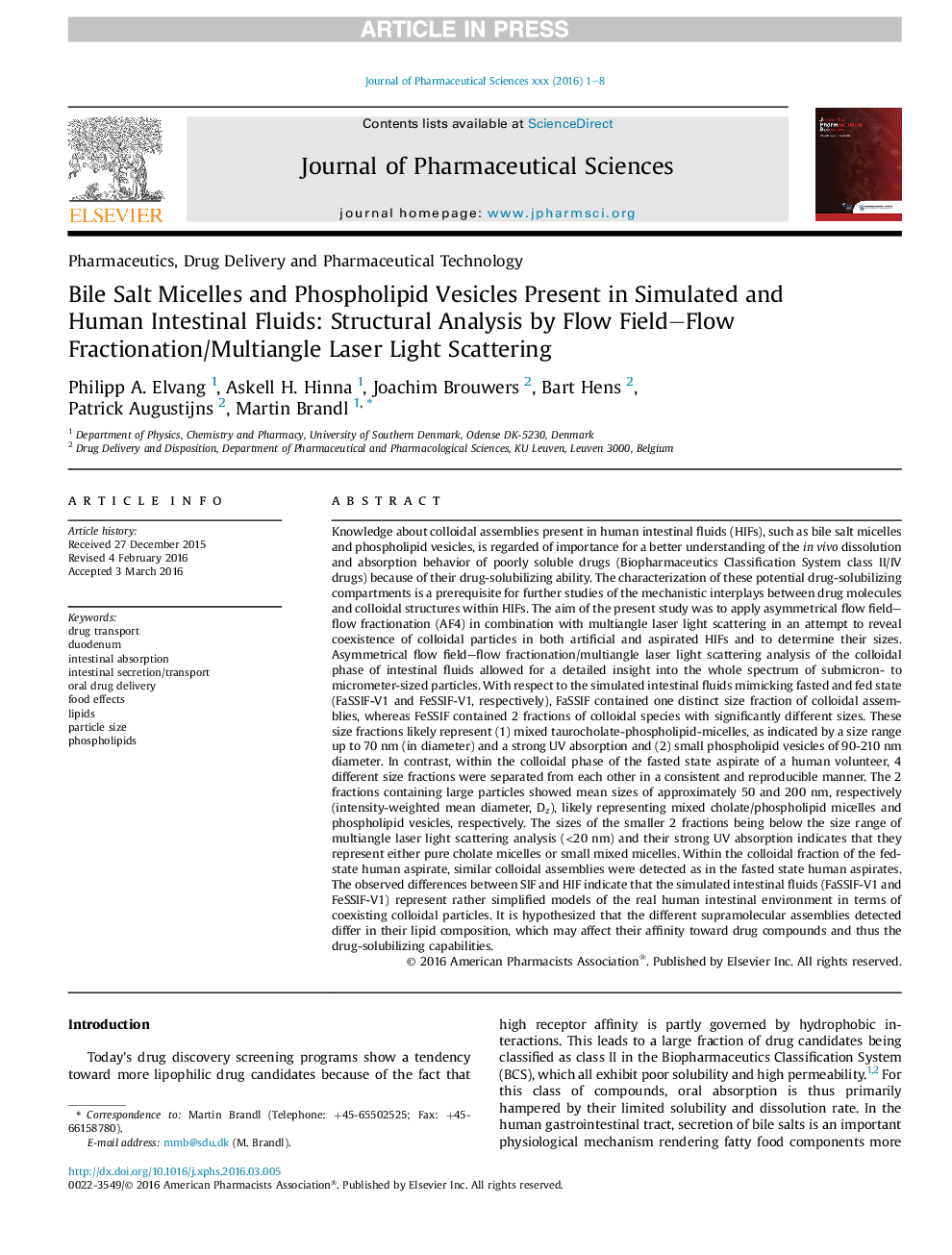| کد مقاله | کد نشریه | سال انتشار | مقاله انگلیسی | نسخه تمام متن |
|---|---|---|---|---|
| 8514999 | 1556513 | 2016 | 8 صفحه PDF | دانلود رایگان |
عنوان انگلیسی مقاله ISI
Bile Salt Micelles and Phospholipid Vesicles Present in Simulated and Human Intestinal Fluids: Structural Analysis by Flow Field-Flow Fractionation/Multiangle Laser Light Scattering
دانلود مقاله + سفارش ترجمه
دانلود مقاله ISI انگلیسی
رایگان برای ایرانیان
کلمات کلیدی
موضوعات مرتبط
علوم پزشکی و سلامت
داروسازی، سم شناسی و علوم دارویی
اکتشاف دارویی
پیش نمایش صفحه اول مقاله

چکیده انگلیسی
Knowledge about colloidal assemblies present in human intestinal fluids (HIFs), such as bile salt micelles and phospholipid vesicles, is regarded of importance for a better understanding of the in vivo dissolution and absorption behavior of poorly soluble drugs (Biopharmaceutics Classification System class II/IV drugs) because of their drug-solubilizing ability. The characterization of these potential drug-solubilizing compartments is a prerequisite for further studies of the mechanistic interplays between drug molecules and colloidal structures within HIFs. The aim of the present study was to apply asymmetrical flow field-flow fractionation (AF4) in combination with multiangle laser light scattering in an attempt to reveal coexistence of colloidal particles in both artificial and aspirated HIFs and to determine their sizes. Asymmetrical flow field-flow fractionation/multiangle laser light scattering analysis of the colloidal phase of intestinal fluids allowed for a detailed insight into the whole spectrum of submicron- to micrometer-sized particles. With respect to the simulated intestinal fluids mimicking fasted and fed state (FaSSIF-V1 and FeSSIF-V1, respectively), FaSSIF contained one distinct size fraction of colloidal assemblies, whereas FeSSIF contained 2 fractions of colloidal species with significantly different sizes. These size fractions likely represent (1) mixed taurocholate-phospholipid-micelles, as indicated by a size range up to 70 nm (in diameter) and a strong UV absorption and (2) small phospholipid vesicles of 90-210 nm diameter. In contrast, within the colloidal phase of the fasted state aspirate of a human volunteer, 4 different size fractions were separated from each other in a consistent and reproducible manner. The 2 fractions containing large particles showed mean sizes of approximately 50 and 200 nm, respectively (intensity-weighted mean diameter, Dz), likely representing mixed cholate/phospholipid micelles and phospholipid vesicles, respectively. The sizes of the smaller 2 fractions being below the size range of multiangle laser light scattering analysis (<20 nm) and their strong UV absorption indicates that they represent either pure cholate micelles or small mixed micelles. Within the colloidal fraction of the fed-state human aspirate, similar colloidal assemblies were detected as in the fasted state human aspirates. The observed differences between SIF and HIF indicate that the simulated intestinal fluids (FaSSIF-V1 and FeSSIF-V1) represent rather simplified models of the real human intestinal environment in terms of coexisting colloidal particles. It is hypothesized that the different supramolecular assemblies detected differ in their lipid composition, which may affect their affinity toward drug compounds and thus the drug-solubilizing capabilities.
ناشر
Database: Elsevier - ScienceDirect (ساینس دایرکت)
Journal: Journal of Pharmaceutical Sciences - Volume 105, Issue 9, September 2016, Pages 2832-2839
Journal: Journal of Pharmaceutical Sciences - Volume 105, Issue 9, September 2016, Pages 2832-2839
نویسندگان
Philipp A. Elvang, Askell H. Hinna, Joachim Brouwers, Bart Hens, Patrick Augustijns, Martin Brandl,